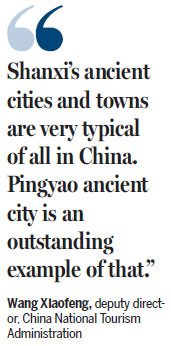Foreign tourists are welcomed to ancient sites and enjoy convenience of high-speed trains from Beijing and Shanghai. Yang Feiyue and Sun Ruisheng report.
Shanxi is going all out to let the world know it abounds in not only coal resources but also profound ancient culture and tourism resources.
The province invited travel agencies from 10 foreign countries on a five-day tour of its ancient cities and towns from Aug 28.
|
Yungang Grottos, which is among major tourist attractions in Shanxi province. Photos Provided to China Daily |
|
Foreign tourists pose with a person dressed like a Qing Dynasty official in the ancient town of Pingyao. |
Local government hoped that those foreign buyers could experience Shanxi themselves and introduce quality local tourism resources to more foreign tourists.
"We welcome foreign friends to visit Shanxi," says Wang Wenbao, deputy director of the Shanxi tourism bureau, assuring that favorable policy, quality service and tourism resources will be offered to the visiting agents or to tourists in the future.
"We'll generally reduce entrance ticket price by 15 percent at public tourist attractions," he says.
Different packages with different prices will be launched for foreign tourists from different areas.
Tourists from Europe and the United States mostly take a shine to the Pingyao ancient city, while those from the Southeast Asia mostly go to Wutai Mountains and Yungang Grottos, which are religious centers, says He Zhiyong, managing director of the Shanxi Cordial International Tours Co, a major local travel agency dealing with foreign tourists to Shanxi.
To date, France is the biggest source of tourists to Shanxi. Those from Germany, Japan and South Korea have also contributed a lot to local tourism development.
"We hope our inbound tourism will maintain an annual growth of 10-20 percent in the future," Wang says.
Approximately 380,000 tourists from outside the mainland stayed at hotels in Shanxi during the first eight months this year, up 50.5 percent. The province raked in $197 million in tourism income during the period, up 5.53 percent.
Last year, a total of 800,000 tourists from outside the mainland visited Shanxi.

The introduction of Shanxi's tourism resources to the outside world is also part of efforts to strengthen cooperation and exchanges with countries and regions that support China's One Belt, One Road initiative.
Ancient cities and towns are an important part of global cultural heritage, says Wang Xiaofeng, deputy director of the China National Tourism Administration.
"Shanxi's ancient cities and towns are very typical of all in China. Pingyao ancient city is an outstanding example of that," Wang says.
The ancient city has been considered one of the four best-preserved across China, and it was rated by the World Heritage Committee as the best-preserved ancient county in China and an outstanding example of ethnic Han cities of Ming (1368-1644) and Qing (1368-1911) dynasties.
Representatives from Germany, France, Canada, Spain, Italy, Russia, Japan, South Korea, Thailand and Malaysia were divided into two groups to savor tourism resources across the province, including Mount Wutai in Xinzhou, Pingyao ancient city in Jinzhong, Hanging Temple in Datong, Hukou Waterfall in Linfen and the Prime Minister's Palace in Jincheng.
He's company has brought tourists to many sites in Shanxi from North Europe, North America and Southeast Asia.
The number of tourists from South Korea and Malaysia to Shanxi witnessed a 20-percent growth after a global buyer's meeting last October, He Zhiyong claims. His company has been talking with travel agencies in Los Angeles and San Francisco to bring US tourists to Shanxi via Beijing next year.
The development of high-speed rails connecting Beijing, Shanxi province's capital city Taiyuan and Shaanxi province's capital city Xi'an has played an important role in boosting the tourism business in Shanxi. The rails have not only shortened travel times to just a few hours but also delivered a refreshing experience for travelers abroad, He explains.
"We'll rely on foreign tourists to Beijing and encourage them to visit Shanxi by taking the high-speed rail."
Foreigners are especially interested in Shanxi's folk customs and ancient towns. They often stay at Pingyao for two to three days, and they are fascinated by the fact that many locals still live in the ancient city.
The morning food market fair and private shops are among the favorite stops for foreigners, He says.
Jessica Arjona from ICU Viajes SA, a travel agency based in Spain, was impressed by Pingyao ancient city among other tourist sites that include Jinci and Hanging temples.
"We've always seen big cities when we visit China, and it's rare to see a small county like Pingyao, with ancient Chinese elements."
Her company has only taken a dozen Spanish people to Shanxi so far this year, since their operations here are just beginning, she explains.
"We would plan to bring more tourists from Spain after getting a full view of Shanxi's tourism resources this time."
C.K. Cheng, a senior agent with the Canada-based China Travel Service Inc, says that his company began to take Canadian residents to Shanxi eight years ago.
"Our guests love to see those ancient towns and villages in Shanxi, and get to know the ancient culture and history," Cheng explains.
Jinci Temple and Pingyao ancient city are popular among Canadian travelers, and Cheng's company now annually arranges for 50 to 80 Canadians to tour Shanxi and its collection of tourism sites that are near enough to each other for tourists to conveniently explore.
Contact the writers through yangfeiyue@chinadaily.com.cn
(China Daily 09/16/2015 page19)